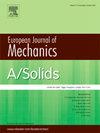Axial compression of cylinders assisted by cyclic torsion of sintered powder iron
IF 4.4
2区 工程技术
Q1 MECHANICS
引用次数: 0
Abstract
The study presents the results of research on porous compacts subjected to complex loading conditions. The sintered samples were produced under standard powder metallurgy (PM) operating conditions. Plastic deformation of the compacts was carried out under compressive conditions with simultaneous oscillatory torsion. The time-variable parameters during compaction included the torsion angle, torsion angle amplitude, and frequency. The influence of the deformation process conditions on the consolidation of compacts and the evolution of porosity was analyzed. Research was conducted to assess changes in density, porosity, and geometry for various deformation variants. Conditions for the most effective densification of porous compacts under free compression with simultaneous oscillatory torsion were identified. The conducted tests revealed that low-density sinters (ρw = 0.75) achieve highly variable densities after deformation, which strongly depend on the set parameters of the torsion angle amplitude (α) and the torsion frequency (f). It was determined in this case that the material densification was more significantly influenced by the torsion frequency (f) than by the value of the torsion angle amplitude (α). For higher-density sinters (ρw = 0.85), achieving high densification is possible with high oscillatory torsion parameters but with much smaller contributions from compressive deformation. Applying compression levels suitable for sinters with lower initial density, combined with maximum oscillatory torsion parameters, results in a loss of material cohesion and the appearance of cracks.
求助全文
约1分钟内获得全文
求助全文
来源期刊
CiteScore
7.00
自引率
7.30%
发文量
275
审稿时长
48 days
期刊介绍:
The European Journal of Mechanics endash; A/Solids continues to publish articles in English in all areas of Solid Mechanics from the physical and mathematical basis to materials engineering, technological applications and methods of modern computational mechanics, both pure and applied research.

 求助内容:
求助内容: 应助结果提醒方式:
应助结果提醒方式:


